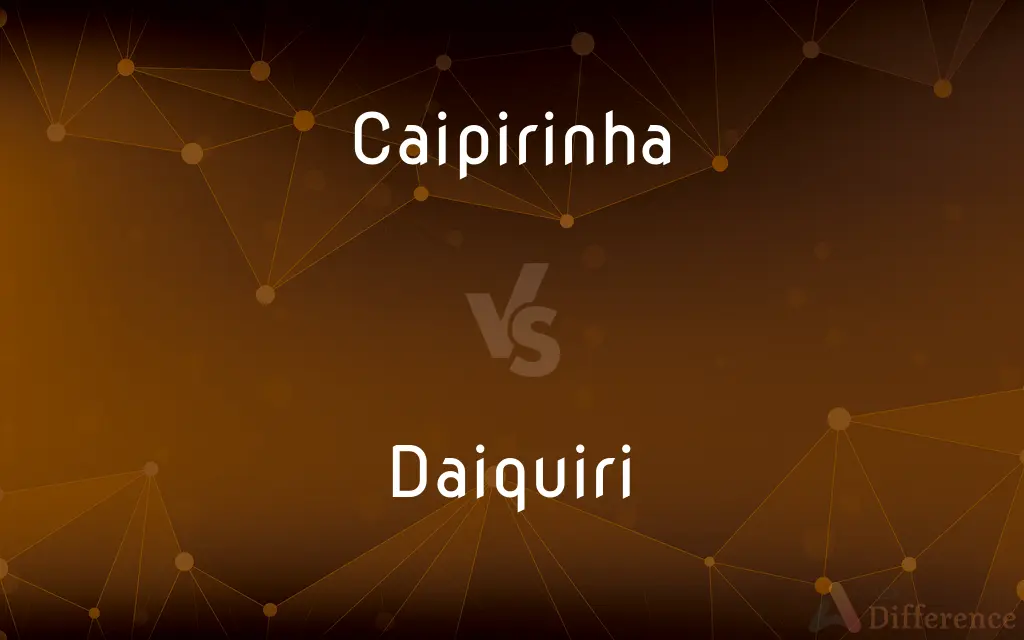Caipirinha vs. Daiquiri — What's the Difference?
By Tayyaba Rehman & Maham Liaqat — Updated on March 25, 2024
Caipirinha, a Brazilian cocktail made with cachaça, sugar, and lime, is tart and strong, while Daiquiri, of Cuban origin, combines rum, lime juice, and sugar for a smoother, citrusy flavor.

Difference Between Caipirinha and Daiquiri
Table of Contents
ADVERTISEMENT
Key Differences
Caipirinha is Brazil's national cocktail, featuring cachaça (a spirit from sugarcane), fresh lime, and sugar. The drink's strength and tartness come from its simple, rustic ingredients. On the other hand, the Daiquiri, hailing from Cuba, is a refined blend of rum, lime juice, and sugar, offering a smooth, well-balanced citrusy taste. Both cocktails share lime and sugar, but the base spirit sets them apart.
The preparation of a Caipirinha involves muddling the lime with sugar to release the essential oils and then mixing it with cachaça. This method preserves the bold flavors of the lime and the sugarcane spirit. Meanwhile, a Daiquiri is typically shaken, combining the ingredients into a cohesive, refreshing drink that highlights the rum's smoothness alongside the sharpness of the lime.
Caipirinha is often served in a thick glass, on the rocks, maintaining a rustic and robust aesthetic that complements its strong flavors. Conversely, Daiquiris are usually served in a cocktail glass, sometimes straight up without ice, which suits its crisp and elegant profile.
The taste profile of a Caipirinha is bold and slightly sweet, with a strong emphasis on the raw sugarcane notes of cachaça. Whereas the Daiquiri, depending on the rum used, can range from light and fruity to more complex and aged flavors, making it a versatile cocktail for various palates.
Despite their shared ingredients, the Caipirinha and Daiquiri offer distinct cultural experiences. The Caipirinha's roots in Brazilian tradition highlight its celebration of local ingredients, while the Daiquiri's connection to Cuba and its popularity in American culture showcase its global appeal and adaptability.
ADVERTISEMENT
Comparison Chart
Origin
Brazil
Cuba
Main Spirit
Cachaça
Rum
Flavor Profile
Tart, strong, and slightly sweet
Smooth, citrusy, and balanced
Preparation
Muddled
Shaken
Serving Style
On the rocks, in a thick glass
Often straight up, in a cocktail glass
Taste Emphasis
Raw sugarcane notes
Varies with rum; can be light or complex
Cultural Significance
Brazilian tradition and local pride
Cuban origin with global popularity
Common Variations
Few; mainly sticks to classic recipe
Many, including flavored and frozen Daiquiris
Compare with Definitions
Caipirinha
A staple in Brazilian social events and gatherings.
Every party in Rio seemed to offer a caipirinha as the welcome drink.
Daiquiri
Can be served straight up or on the rocks.
He preferred his daiquiri straight up, without the dilution of ice.
Caipirinha
A Brazilian cocktail made with cachaça, sugar, and lime.
The caipirinha we had at the beach bar captured the essence of Brazil's spirited nightlife.
Daiquiri
Represents Cuban cocktail craftsmanship and heritage.
The daiquiri, much like the mojito, tells the story of Cuba's rich cocktail history.
Caipirinha
Known for its strong, tart flavor profile.
He enjoyed the caipirinha for its bold taste that differed from sweeter cocktails.
Daiquiri
A Cuban cocktail combining rum, lime juice, and sugar.
She ordered a daiquiri to cool off in the Havana heat.
Caipirinha
Symbolizes Brazilian culture and pride.
Offering a caipirinha to guests is a way to share a piece of Brazilian culture.
Daiquiri
Has numerous variations, including fruit-flavored ones.
The strawberry daiquiri was a hit at the summer party.
Caipirinha
Often served on the rocks in a thick glass.
The caipirinha was served traditionally, on the rocks and ready to stir.
Daiquiri
Celebrated for its smooth, well-balanced citrusy taste.
The bartender's daiquiri was praised for its perfect balance of sweet and sour.
Caipirinha
Caipirinha (Portuguese pronunciation: [kajpiˈɾĩj̃ɐ]) is Brazil's national cocktail, made with cachaça (sugarcane hard liquor), sugar, and lime. The drink is prepared by mixing the fruit and the sugar together, then adding the liquor.
Daiquiri
Daiquiri (; Spanish: daiquirí [dajkiˈɾi]) is a family of cocktails whose main ingredients are rum, citrus juice (typically lime juice), and sugar or other sweetener. The daiquiri is one of the six basic drinks listed in David A. Embury's classic The Fine Art of Mixing Drinks, which also lists some variations.
Caipirinha
A Brazilian cocktail typically made of cachaca, crushed limes, and sugar.
Daiquiri
A cocktail containing rum and lime juice.
Caipirinha
A traditional Brazilian drink prepared with cachaça, lime juice, sugar and ice
Daiquiri
An iced cocktail of rum, lime or lemon juice, and sugar.
Daiquiri
A cocktail of rum, lemon or lime juice and sugar, sometimes with fruit added.
Daiquiri
An alcoholic beverage containing rum and lime or lemon juice, usually mixed with a fruit juice or fruit extract and often blended with crushed ice; as, a strawberry daiquiri.
Daiquiri
A cocktail made with rum and lime or lemon juice
Common Curiosities
How is a Daiquiri usually served?
Often straight up in a cocktail glass, but it can also be served on the rocks.
What flavors dominate in a Caipirinha?
Tart, strong, and slightly sweet, emphasizing the raw sugarcane notes of cachaça.
What is the main spirit in a Caipirinha?
Cachaça, a Brazilian spirit made from sugarcane juice.
Is lime a common ingredient in both cocktails?
Yes, lime is essential for both, providing the citrusy backbone of their flavor profiles.
What is the ideal occasion for serving a Caipirinha?
It's perfect for warm, casual gatherings to bring a taste of Brazilian festivity.
Can you make a Daiquiri with different types of rum?
Yes, Daiquiris can be made with various types of rum, affecting the cocktail's flavor profile.
Is a Caipirinha considered a strong drink?
Yes, it is known for its strong flavor due to the high alcohol content of cachaça and minimal mixers.
What are some popular variations of Daiquiris?
Flavored Daiquiris like strawberry or mango, and frozen Daiquiris are among the popular variations.
What is the cultural significance of a Caipirinha in Brazil?
It symbolizes Brazilian tradition and pride, often served at social events and celebrations.
What makes a Daiquiri smooth?
The combination of rum with the balanced acidity of lime juice and sweetness of sugar creates a smooth taste.
Are there variations of Caipirinhas?
While there are few variations, the classic recipe remains the most popular.
Can both cocktails use sugar syrup instead of granulated sugar?
Yes, though Caipirinha traditionally uses granulated sugar to muddle with lime, both can adapt to using syrup.
How has the Daiquiri gained global popularity?
Its versatility and the influence of Cuban cocktail culture have made it a favorite worldwide.
How does the preparation of Caipirinha and Daiquiri differ?
Caipirinha is muddled to blend the lime and sugar, while Daiquiris are typically shaken.
What distinguishes the serving style of Caipirinha from Daiquiri?
Caipirinha is typically served on the rocks in a thick glass, while Daiquiris are often served straight up in a cocktail glass.
Share Your Discovery

Previous Comparison
Military vs. Defence
Next Comparison
Bit vs. BollardAuthor Spotlight
Written by
Tayyaba RehmanTayyaba Rehman is a distinguished writer, currently serving as a primary contributor to askdifference.com. As a researcher in semantics and etymology, Tayyaba's passion for the complexity of languages and their distinctions has found a perfect home on the platform. Tayyaba delves into the intricacies of language, distinguishing between commonly confused words and phrases, thereby providing clarity for readers worldwide.
Co-written by
Maham Liaqat













































